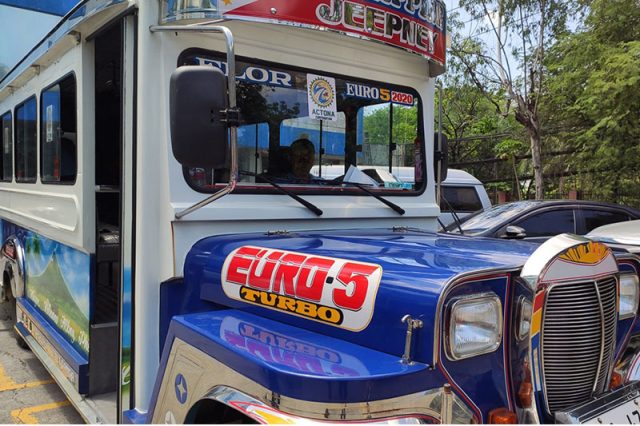
SPONSORED ARTICLES
A transport group presented an alternative version of a modernized jeepney which it claimed is cheaper than the imported minibus presented by the government.
The Association of Committed Transport Organizations Nationwide Corporation (ACTONA) on Monday showed its version which still resembles the iconic look of the traditional jeepney but with upgraded features.
Reports said the organization’s prototype has a higher ceiling that accommodates standing passengers, handrails, built-in security cameras, and an environment-friendly Euro 5 engine.
It also features two doorways — the one on the right side near the driver and an exit door at the back which can accommodate a ramp for people with disabilities.
ACTONA said the prototype costs around P1.3 million if non-airconditioned and P1.5 if with aircon.
It also said that it did not use imported materials.
Meanwhile, the minibus being eyed by the government costs around P2.4 to P2.8 million each.
The organization said its prototype was finished in 2019, but the Duterte administration was not open to discussions to adopt it.
The previous administration initiated the Public Utility Vehicle (PUV) Modernization Program in 2017 in a bid to make the country’s public transport efficient and environment-friendly by 2020.
ACTONA chair Juancho Caparino said they have talked and presented their prototype jeepney to Land Transportation and Franchising Regulatory Board chair Teofilo Guadiz III.
“Now, after our talk with Guadiz, it seems like it will push through because he already approved it,” Caparino was quoted as saying.
Guadiz also said that ACTONA’s model conforms with the requirements of the Bureau of Philippine Standards, which certifies products for safety and quality in accordance with the Philippine National Standards (PNS).
The LTFRB chair said that “there would be no need for phaseout” of traditional jeepneys if operators and drivers would adopt the prototype and ensure its compliance with requirements.
“It’s cheaper, conforms with the PNS, and it preserves the iconic picture of the jeepney. That is acceptable for us and the jeepney operators may use that as a mode of transportation,” Guadiz said.
A video of Guadiz’s inspection was uploaded on the Facebook page of Radyo Pilipinas.
An architect also shared a proposed architectural design for a modernized jeepney which she said still embraces Filipinos’ cultural roots despite the upgrade.
“Traditional Jeepney is part of our culture (considered one of the icons of our country) and a reflection of the Filipino Spirit,” Winonalyn Corcuera, principal architect at U6 Design Studio, said on Facebook on March 3.
“The solution, instead of phasing them out, is to help our jeepney drivers and upgrade our traditional jeepneys to accompany the fast-changing technology while still embracing our cultural roots. Here’s one example of how we can upgrade and improve our traditional jeepneys,” she added.
Corcuera shared pictures of what they called the “HaruROOT” jeepney she designed with Darylle Ann Caasi Cea and Shenice Sapin.
The modern jeepney eyed by the government appears like a minibus.
In 2019, several manufacturers shared their designs for the upgraded version of the iconic “King of the Road.”
Some have standing capacities, are airconditioned, and has PWD lifting access.
Others have accessories such as CCTVs and GPS.
All of them are powered by Euro 4-compliant diesel engines.
Transport advocate Reycel Hyacenth Nacario Bendaña, also a daughter of a jeepney driver, previously said that they are not against the PUV Modernization Program.
According to her, they are fighting against the complete phaseout of the vehicles.
RELATED: ‘Modernisasyon, hindi phase-out’: The battlecry of jeepney drivers, operators
Drivers and operators of traditional jeepneys and UV Express planned to hold a week-long transport strike to oppose the implementation of the PUV Modernization Program from March 6 to 12.
Manibela and PISTON ended this strike after having talks with the Office of the Executive Secretary.
The PUV Modernization Program mandates franchise holders to join cooperatives to supposedly afford the modern jeepneys.
Some transport groups said the program is anti-poor due to the cost of proposed upgraded vehicles. Others claimed it could be used as a ploy to increase vehicle sales of major automotive companies and foreign businesses.
Guadiz previously said that transport workers do not need to fear the program since there are processes for loans for the purchase of compliant vehicles.
Proposed alternative: Transport group presents version of modern jeep to LTFRB
Source: Filipino Trend Viral
0 Comments